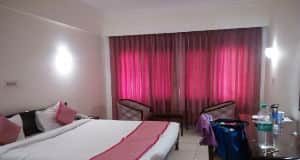Ayodhya, the Birthplace of the Lord Rama
Ayodhya, known as Ram Janmbhoomi or birthplace of Rama, was once known as Saket. It is one of the most important pilgrimage spots in India and has been mired in controversy over the Babri Masjid said to have been built at the site of a temple marking the birthplace of Lord Rama. Apart from being the setting for the epic Ramayana, Ayodhya has a few other interesting spots such as Nageshwarnath temple said to have been built by Kush, Lord Rama’s son to acknowledge the help he received from a Naga Kanya to retrieve his army. Ramkot, in the western side attracts millions of devotees with the place taking on a festive look on Ramnavmi day. Lakshmana Ghat is where Lakshman gave up his life after lifelong devotion to his brother and Swarg Dwar is from where Lord Rama is said to have attained the form of Lord Mahavishnu and left for his heavenly abode.

History
Ayodhya finds mention in the Puranas with the Skanda and Brahmanda Purana giving it the status of one of the six most holy cities for Hindus. Around 600 BC Ayodhya was an important trade center and a flourishing city. The Atharva Veda describes Ayodhya as a city built by Gods and like a veritable paradise.
According to legend Manu founded Ayodhya and it was the seat of power of the Surya dynasty with Lord Rama being its most illustrious personality. It was capital of Kosala ruled by Lord Dasharatha of the Surya dynasty of the Ikshvakus founded by Ikshvaku, eldest son of Manu. Prithvi, the sixth in the line had the Earth named after him. Raja Harishchandra, the staunch upholder of truth, ruled here. Raja Sagar performed the Ashwamedha Yagna here and his grandson Bhagiratha performed penance to bring Ganga to Earth. Raja Dasaratha happened to be the grandson of Bhagirath and father to Lord Rama, an incarnation of Vishnu. Brihabdala, the last of the Ikshvaku clan, the 93rd in the line and 30th from Lord Rama was killed in the Mahabharat wars. It is said Tulsidas penned the Ramayana at this place around 1574 CE. Ayodhya is equally important for the Jains, holding the distinction of being the birthplace of five Tirthankars including Shri Rishabh Dev, said to be the father of Jainism. For Buddhists too, the city is of importance since it was an important city of the Mauryan and Gupta empires during which period it was at its zenith. Known as Saket, it was a prime centre for the Buddhist in the 5th century BC. The Maurya dynasty ended, the Guptas rose and fell and after the attack by the Huns, the city fell into obscurity as the capital was moved to Kannauj.
Lord Neelkantha, founder of the Swaminarayan Sect, is believed to have lived here and commenced his journeys across India from this city.
Ayodhya’s fame reached far and the Indonesian city of Yogyakarta and the Thai city of Ayuthaaya were named after this holy Hindu city. Even the Koreans mention Ayodhya, stating that Samguk Yusa the wife of King Suro of the ancient kingdom of Geumgwan Gaya originated from this city while others place it in Ayuthaaya in Thailand.
Lord Vikramaditya saw Rama in dream and he rebuilt Ayodhya according to the instructions given by the Lord, restoring it to its glory.
However, it was not until Ramananda, a Hindu mystic established the sect of Rama around 1400s that the city attained the status of a pilgrimage spot. Around 1226 AD the city became the capital of Awadh. Sometime in 1528 AD, Babar established the Babri Masjid here over the site of the original Ram temple. In the 16th century the Mughals established supremacy and ruled until the British took it over around 1856 taking advantage of the rift between the Shias and the Sunnis. It was here that the seeds of the revolution were sown around 1857.
Places to See
Apart from the Babri Masjid, Ram Temple, Ayodhya has a few places you might like to visit when you are here.
Nageshwarnath Temple
Located on the side of the Saryu River, this temple is said to have been built by Kush, Lord Rama’s son to honor a Naga girl who helped him save his armies.
Ramkot
Ramkot is the ancient place of worship that draws millions of pilgrims, located in the western portion of the city.
Lakshman Ghat
Lakshman Ghat on the banks of the Saryu River is where Lakshman gave up his life by entering into a Samadhi because he broke his vow.
Swarg Dwar
Swarg Dwar is where Lord Rama is said to have attained the form of Lord Mahavishnu and entered his heavenly abode.
Treta ka Thakur
A temple said to be the spot where Lord Rama performed the Ashwamedha Yagna. The site is marked by a more modern temple built by Raja of Kulu who installed the ancient idols of Rama, Lakshman and Bharat here.
Hanuman Garhi
Hanuman Garhi is a massive fort-like structure with a temple inside that you must visit when you are here.
Kanak Bhavan
Kanak Bhavan is close to Hanuman Garhi and has idols of Lord Rama and Sita.
Choti Chawni
Choti Chawni is a large temple constructed in white marble and a place you must not miss.
Vijaraghav Temple
Vijaraghav temple is a fine temple built in 2008 made of red marble and steel, dedicated to Lord Rama.
Mani Parbat & Sugriv Parbat
You might also like to visit Mani Parbat and Sugriv Parbat, said to be Buddhist caves at a distance from the city.
There are other places of interest such as the Rishabhdeo Jain temple, Angad Tila, Sri Rama Janaki Birla Temple, Ram Ki Paidi, Janki Mahal, Ram Katha Museum, Raja Dashrath Samadhi Sthal and the Vashisth Ashram in Delasiganj, to name only a few.
Fairs and Festivals
- The Land of Rama is popular for its Ramleela, plays that enact scenes from the Ramayana. You can attend these at any time but then there are thousands thronging to such plays during the time of Dussehra and Ramnavmi when the city comes alive with pilgrims. There is dance, Kathak dances and songs that make for a riveting performance.
- In the month of April the city comes alive on Ram Navmi Day with the Ram Navmi Mela drawing crowds by the thousands, especially around the Kanak Bhavan.
- The Sravan Jhula Mela is another event, held during the second half of the month of Sravan, when the idols of Lord Rama, Lakshman and Sita are placed in swings and taken to Mani Parbat and the swings are hung from the tree branches. Festivities last throughout the second part of the Sravan month.
Shopping
A holy city, Ayodhya offers you a lot of religious products. You can buy Ramnami towels, Kurtas and handicraft bags emblazoned with name of Lord Rama. You can buy and sample Khurchan Peda, a sweet made of milk, Laddoos and snacks. You can go shopping for brass and copper lamps, marble idols of gods, Tulsi bead necklaces, CDs and books.
Location
The holy city of Ayodhya is located on the banks of the Saryu River in Faizabad district in the south of Uttar Pradesh, about 550 km East of New Delhi.
How to Reach Ayodhya
By Road
Ayodhya is easily accessible by road, being 636 km from Delhi, 130 km from Lucknow, 160 km from Allahabad, 140 km from Gorakhpur and 200 km from Varanasi. One can travel by road from Delhi or any other major city to Ayodhya. There are state transport buses, private taxis and private cars from major cities in Uttar Pradesh to take you to Ayodhya.
By Train
The closest Railhead is Faizabad, about 6 km away. One can also get into a train from Delhi, Varanasi, Allahabad or Lucknow to reach Ayodhya.
By Air
The nearest airport is Faizabad but flights are infrequent to this airport. Lucknow, about 130 km, receives regular flights.
Weather
Located in North India in the sub-Himalayan region, Ayodhya does experience extremes of weather. In summer it becomes torrid and hot with maximum temperatures climbing up to 42 deg. C. with an average of 37 deg. C. Winters can range from pleasantly cool at 22 deg. C. to a chilly 8 deg. C. or even lower at times. The region experiences normal rainfall during monsoons. The best time to visit Ayodhya is just after monsoons have ended in September-October when it is neither too hot nor too cold. Spare time of at least a week to get to know this city well.
Accommodation
A city that welcomes pilgrims, Ayodhya has accommodation ranging from the most expensive five star style hotels to modest hotels and low end dormitories where you can get a bed for less than Rs. 100 for the night. However, pilgrims traveling with families will find dozens of Dharamshalas that offer low cost, safe and comfortable accommodation.
A visit to Ayodhya is not only a pilgrimage that gets you merit but also a travel in time for a nostalgic glimpse centuries of history at each turn and corner.


